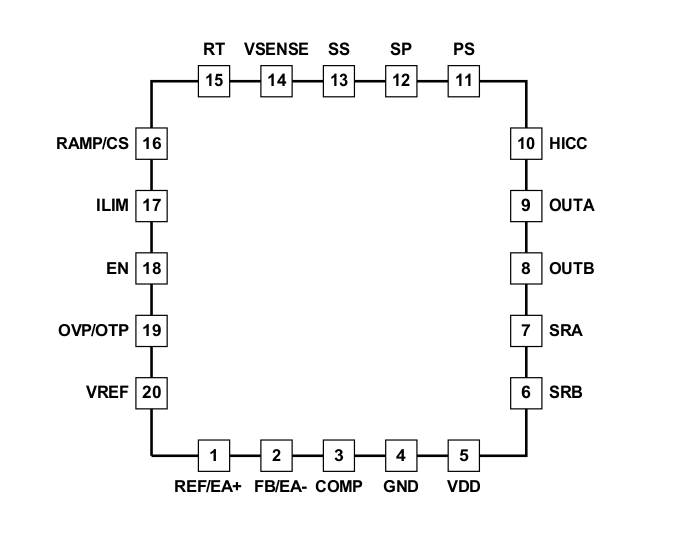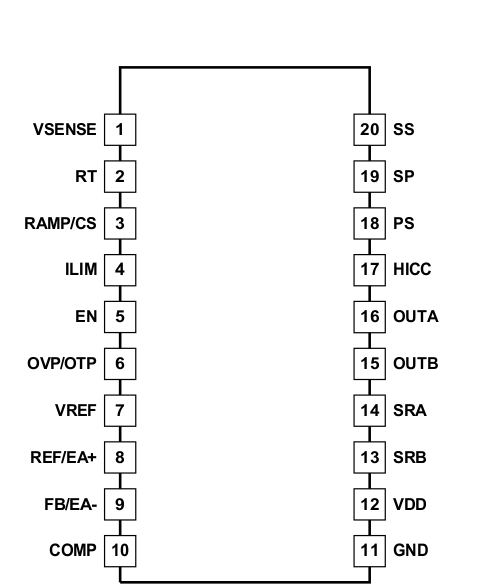SLUSA29D April 2010 – August 2015 UCC28250
PRODUCTION DATA.
- 1 Features
- 2 Applications
- 3 Description
- 4 Revision History
- 5 Pin Configuration and Functions
- 6 Specifications
-
7 Detailed Description
- 7.1 Overview
- 7.2 Functional Block Diagram
- 7.3
Feature Description
- 7.3.1 VDD (5/12)
- 7.3.2 VREF (Reference Generator) (20/7)
- 7.3.3 EN (Enable Pin) (18/5)
- 7.3.4 RT (Oscillator Frequency Set and Synchronization) (15/2)
- 7.3.5 SP (Synchronous Rectifier Turnoff to Primary Output Turnon Dead Time Programming) (13/19)
- 7.3.6 PS (Primary Output Turnoff to Synchronous Rectifier Turnon Dead Time Programming) (11/18)
- 7.3.7 RAMP/CS (PWM Ramp Input or Current Sense Input) (16/3)
- 7.3.8 REF/EA+ (1/8)
- 7.3.9 FB/EA- (2/9)
- 7.3.10 COMP (3/10)
- 7.3.11 VSENSE (14/1)
- 7.3.12 SS (Soft Start Programming Pin) (13/20)
- 7.3.13 ILIM (Current Limit for Cycle-By-Cycle Overcurrent Protection) (17/4)
- 7.3.14 HICC (10/17)
- 7.3.15 OVP/OTP (19/6)
- 7.3.16 OUTA (9/16) and OUTB (8/15)
- 7.3.17 SRA (7/14) and SRB (6/13)
- 7.3.18 GND (4/11)
- 7.4 Device Functional Modes
-
8 Applications and Implementation
- 8.1 Application Information
- 8.2
Typical Applications
- 8.2.1
Design Example
- 8.2.1.1 Design Requirements
- 8.2.1.2
Detailed Design Procedure
- 8.2.1.2.1 Step 1, Power Stage Design
- 8.2.1.2.2 Step 2, Feedback Loop Design
- 8.2.1.2.3 Step 3, Programming the Device
- 8.2.1.2.4 Step 3-3, Determine Soft-Start Capacitance
- 8.2.1.2.5 Step 3-4, Determine Dead-Time Resistance
- 8.2.1.2.6 Step 3-5, Determine OCP Hiccup Off-Time Capacitance
- 8.2.1.2.7 Step 3-6, Determine Primary-Side OVP Resistance
- 8.2.1.2.8 Step 3-7, Select Capacitance for VDD and VREF
- 8.2.1.3 Application Curves
- 8.2.2 Secondary-Side Half-Bridge Controller with Synchronous Rectification
- 8.2.1
Design Example
- 9 Power Supply Recommendations
- 10Layout
- 11Device and Documentation Support
- 12Mechanical, Packaging, and Orderable Information
Package Options
Mechanical Data (Package|Pins)
Thermal pad, mechanical data (Package|Pins)
- RGP|20
Orderable Information
5 Pin Configuration and Functions
RGB Package
20-Pin VQFN
Top View

PW Package
20-Pin TSSOP
Top View

Pin Functions
| PIN | I/O | DESCRIPTION | ||
|---|---|---|---|---|
| NAME | QFN | PW | ||
| COMP | 3 | 10 | I/O | Error amplifier output |
| EN | 18 | 5 | I | Device enable and disable |
| FB/EA- | 2 | 9 | I | Error amplifier inverting input |
| GND | 4 | 11 | I | Ground |
| HICC | 10 | 17 | I | Cycle-by-cycle current limit time delay and Hiccup time setting |
| ILIM | 17 | 4 | I | Current sense for cycle-by-cycle overcurrent protection |
| OUTA | 9 | 16 | O | 0.2-A sink/source primary switching output |
| OUTB | 8 | 15 | O | 0.2-A sink/source primary switching output |
| OVP/OTP | 19 | 6 | I | Overvoltage and overtemperature protection pin |
| PS | 11 | 18 | I | Primary off to synchronous rectifier on dead-time set |
| RAMP/CS | 16 | 3 | I | PWM ramp input (for voltage mode control) or current sense input (for current mode control) |
| REF/EA+ | 1 | 8 | I | Error amplifier noninverting input |
| RT | 15 | 2 | I | Oscillator frequency set or synchronous clock input |
| SP | 12 | 19 | I | Synchronous rectifier off to primary on dead-time set |
| SRA | 7 | 14 | O | 0.2-A sink/source synchronous rectifier output |
| SRB | 6 | 13 | O | 0.2-A sink/source synchronous rectifier output |
| SS | 13 | 20 | I/O | Soft-start programming |
| VDD | 5 | 12 | I | Bias supply input |
| VREF | 20 | 7 | O | 3.3-V reference output |
| VSENSE | 14 | 1 | I | Output voltage sensing for prebias control |